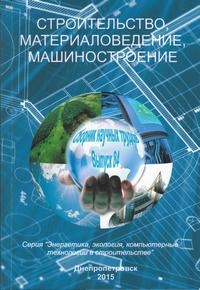Features of heavy metals behaviour in water solutions and removal of compounds of iron from sewage
Keywords:
Heavy metal reagent method, wastewater, lime, iron compounds.Abstract
The purpose is to determine the effect of pH on the solubility of heavy metals: iron, aluminum, nickel and chromium, the rationale for increasing the content of iron compounds after pretreatment in water treatment systems, as well as the influence of temperature and concentration of the acid in the wastewater metallurgical industries on the degree and rate of deposition of iron.
Methodology. Performing research involved the use of analytical methods for the determination of metals with the use of model solutions in the laboratory, as well as to determine the conditions of deposition of iron compounds from industrial wastewater metallurgical industries, depending on the acid concentration and solution temperature.
Findings. The process of deposition of heavy metals from waste water is most expedient to carry out using lime. The values of optimum pH at which there is a minimum concentration of individual metals is significantly different. When exceeding the optimum pH values the residual metal concentration increases.
Originality. The optimal conditions for the deposition of heavy metals identified. Analytic depending are received and is given the interpretation of the causes of increasing iron content in industrial units. The characteristics of the precipitation of iron compounds from solution, depending on the acid concentration and temperature of the solution are defined. Analytical dependences characterizing the influence of these factors on the process of deposition are given.
Practical value. Heavy metals are a source of contamination of drinking water and process water industry. Optimization of conditions for the removal of metals from aqueous solutions is important for the preservation of human health and improve the reliability of the company.
References
Averin G.V., Zvyagintseva A.V. Opasnost i risk kak harakteristiki osobyh sostoyaniy ekologicheskih i tehnogennyh sistem [Danger and risk as descriptions of the special states of the ecological and technogenic systems]. Ekologichna bezpeka – Ecological safety, 2008., no 2, pp. 22-30. http:// ……
Vasilev A.N., Tundel N.N. Tehnologii rasprostraneniya tyazhelyh metallov v okruzhayushchey srede [Technology of heavy metals in the environment]. Ekotehnologiya i resursosberezhenie. – Environmental technology and resources, 2000, no 2, pp. 36-44. http:// ……
Lure Yu.Yu. Analiticheskaya himiya promyshlennyh stochnyh vod [Analytical chemistry of industrial waste water]. Moscow: Chemistry, 1984. – 464 p. http:// ……
Pilipenko A.T., Pyatnitskiy I.V. Analiticheskaya himiya [Analytical Chemistry]. Vol.1 Moscow: Chemistry, 1990. – 480 p. http:// ……
Bernard Aube. The Science of Treating Acid Mine Drainage and Smelter Effluents. 21 p. http://www.infomine.com/publications/docs/Aube.pdf
David M. Ayres. Removing Heavy Metals from Wastewater Engineering Research Center Report. University of Maryland. 1994, 21 p. http:// ……
Gameiro M.L.F. Nano seed-mediate precipitation of iron as crystalline natrojarosite Technical University of Lisbon, Portugal, 2011, pp. 4. http:// ……
Heavy metals in wastewaters. Removal and Analyses. Ramboll. Heavy metals in wastewaters. 2013/3/22.http://www.ecoprofi.info/docs/event_2013-03-22_presentation_Ramboll_Varpula_en.pdf
M. Vrijheid. Hazard potential ranking of hazardous waste sites and risk of congenital anomalies. OccupationalEnvironmental Medicine, 2002. issue 59 (II), pp. 768-776. http:// ……
Piero M. Armenante. Precipitation of Heavy Metals from Wastewater. NJIT. 1999. pp. 41. http:// ……
Robert W. Peters and Linda Shem. Separation of heavy metals: Removal from industrial wastewater and contaminated soil Energy System Division. Argonne National Laboratory. Argonne, Illinois 60439, 2009, pp. 62. http:// ……
Roger Batstone, James E. Smith, Jr. and David Wilson. The Safe Disposal of Hazardous Wastes. The special Needs and Problems of Developing Countries. Volume II. A joint study: The World Bank, World Health Organization, United Nation Environment Programme. Washington, D.C., 1989, pp. 270-552. http:// ……
Teresia Wӓllstedt. Influence of acidification and liming on metals in lake sediments. Stockholm’s University, Stockholm, 2005, pp. 30. http:// ……
Downloads
Published
Issue
Section
License
Редакція Видання категорично засуджує прояви плагіату в статтях та вживає всіх можливих заходів для його недопущення. Плагіат розглядається як форма порушення авторських прав і наукової етики.
При виявлені у статті більш ніж 25% запозиченого тексту без відповідних посилань та використання лапок, стаття кваліфікується як така, що містить плагіат. У цьому випадку стаття більше не розглядається редакцією, а автор отримує перше попередження.
Автори, в статтях яких повторно виявлено плагіат, не зможуть публікуватися в усіх журналах Видавництва ДВНЗ «Придніпровська державна академія будівництва та архітектури».
Автори, які публікуються у цьому журналі, погоджуються з наступними умовами:
- Автори залишають за собою право на авторство своєї роботи та передають журналу право першої публікації цієї роботи на умовах ліцензії Creative Commons Attribution License, котра дозволяє іншим особам вільно розповсюджувати опубліковану роботу з обов'язковим посиланням на авторів оригінальної роботи та першу публікацію роботи у цьому журналі.
- Автори мають право укладати самостійні додаткові угоди щодо неексклюзивного розповсюдження роботи у тому вигляді, в якому вона була опублікована цим журналом (наприклад, розміщувати роботу в електронному сховищі установи або публікувати у складі монографії), за умови збереження посилання на першу публікацію роботи у цьому журналі.
- Політика журналу дозволяє і заохочує розміщення авторами в мережі Інтернет (наприклад, у сховищах установ або на особистих веб-сайтах) рукопису роботи, як до подання цього рукопису до редакції, так і під час його редакційного опрацювання, оскільки це сприяє виникненню продуктивної наукової дискусії та позитивно позначається на оперативності та динаміці цитування опублікованої роботи (див. The Effect of Open Access).

